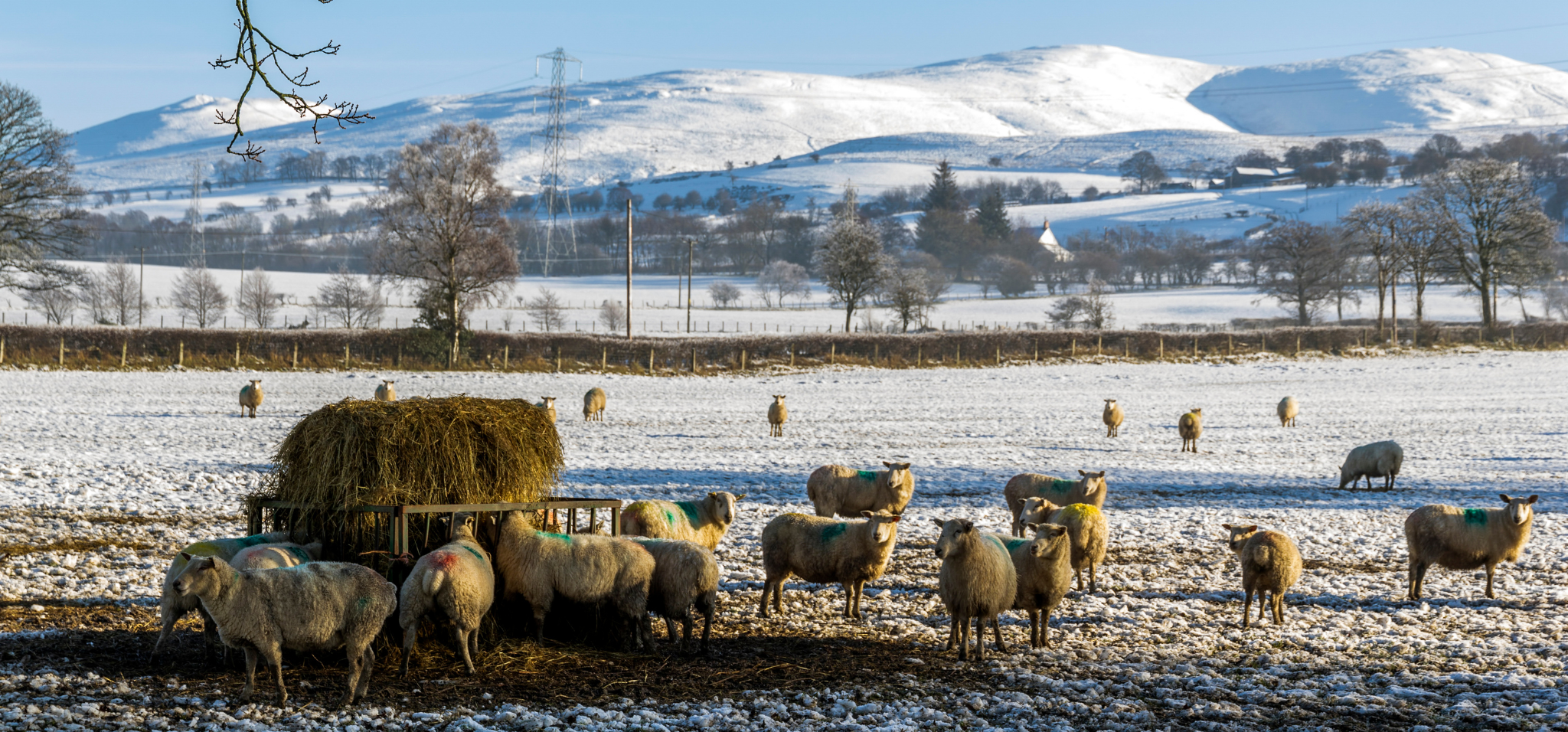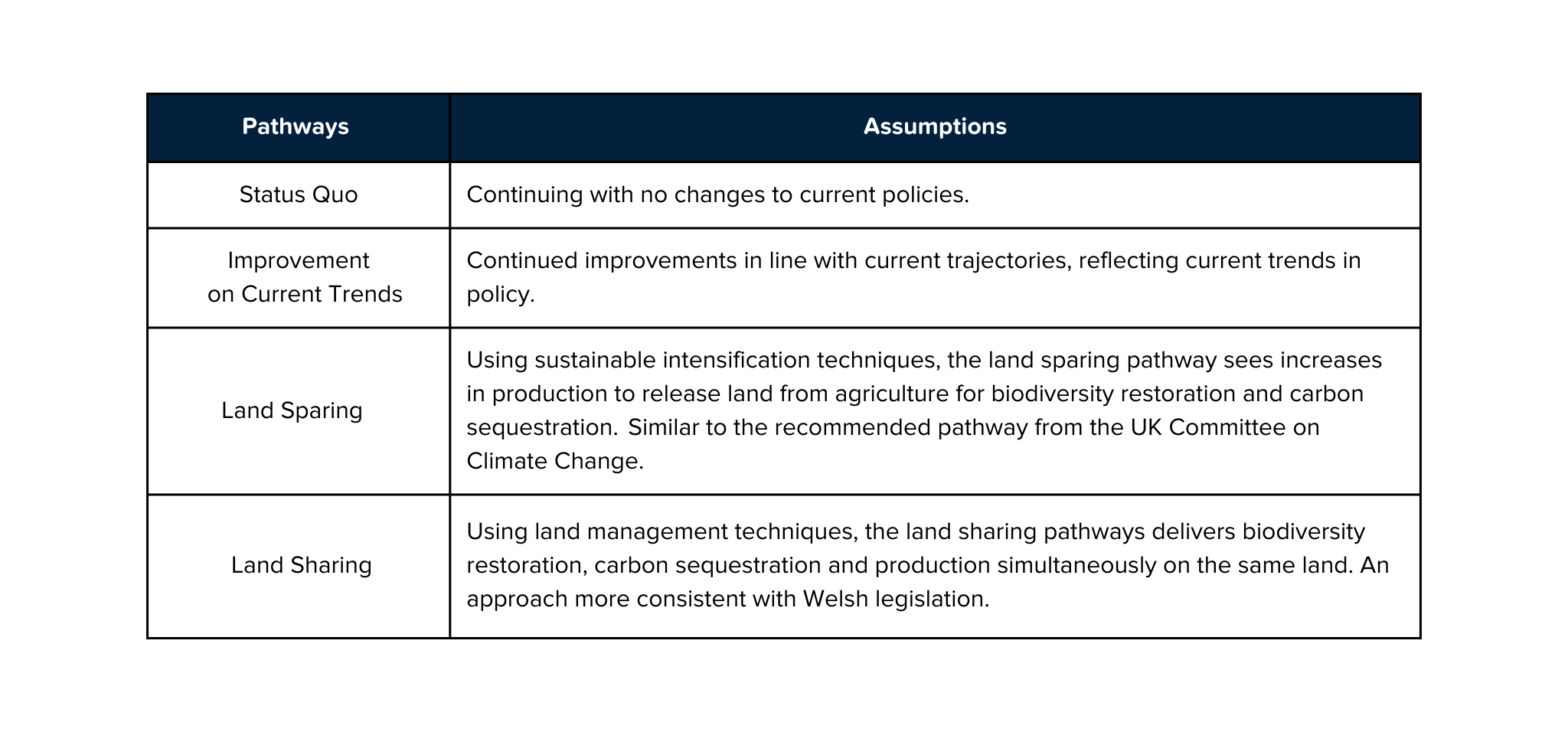
Author: Sarah Jones (Lancaster University, FABLE UK).
The UK FABLE team has been collaborating with the Welsh Government to develop a sub-national Calculator, with four pathways for nature positive and carbon neutral land use and food systems to 2050. The process allowed the Welsh Government to explore pathways that align with their long-term policy aspirations, some of which differ from those of the UK Government. The pathways and results were very warmly received by the team in the Welsh Government, as well as wider policy departments.
“Working in partnership with our academic partners really helped us to tailor the model to meet our specific policy needs. As a result of this close collaboration the outputs of the work has had a significant impact on policy thinking in Welsh Government and continues to do so.” —Ann Humble – Head of Strategic Analysis, Welsh Government.
Background & Context:
The UK governance is complex, with the overall UK Parliament at Westminster, which also has responsibility for policies that apply to England only. Devolved administrations exist in Wales, Scotland, and Northern Ireland, each with differing devolution settlements. Wales, located to the west of England, covers an area of 2,077,000 hectares. It is predominantly comprised of grazed grassland (70% of the land area), with 25% being rough pasture, and approximately 15% covered by forests (Rowland et al., 2017).
Wales's natural environment is considered one of its most precious resources, playing a central role in the health and well-being of the population and economy (Natural Resources Wales, 2020a). Due to the wet climate and mountainous areas, most of Wales's land is better suited to pasture and livestock farming rather than arable cropping, with only a small number of holdings dedicated to crops (Armstrong, 2016).
Wales is subject to the administration of the UK Government in Westminster and the Welsh Senedd in Cardiff (ONS, 2021). The Welsh Senedd has devolved competency for environment and agricultural policy but lacks responsibility for energy policy or trade at a strategic level. Welsh Ministers have committed to achieving net-zero carbon by 2050 through amendments to The Environment (Wales) Act 2016. Further commitments include maintaining and enhancing a biodiverse natural environment domestically through the Well-being of Future Generations (Wales) Act (Welsh Government, 2015), and the Nature Recovery Action Plan 2020–21 (Welsh Government, 2020).
Therefore, given the pressure of delivering on Wales’s own domestic climate commitments, those of the UK, as well as the departure of the UK from the EU, the Welsh Government is at a significant point in terms of designing future policy.

Application of nexus tools to support coherence in policy formulation
Representatives from the devolved administrations have been involved in the development of the UK Pathways since the first FABLE scenathon in 2019. It was through the workshops presenting the 2020 scenathon results that colleagues in the Welsh Government became more aware of the work of FABLE and its capabilities. Specifically, FABLE’s ability to model different policy aspirations was of particular interest.
An initial concept meeting was held to define the overall scope of the work, which included determining the number of pathways to develop and their overall narrative, a summary of which is presented in Table 1. Once this was decided, a template listing the assumptions and data required to parameterize each pathway was shared with the Welsh Government team.
Table 1: The four pathways co-developed by the FABLE team and Welsh Government.

This template was gradually filled with explicit assumptions to represent both current and future policy ambitions in a series of meetings, supplemented by email exchanges. This iterative process enabled the UK FABLE team to explain the precise requirements for the calculator, and it allowed the Welsh Government to gain an increased understanding of the calculator's capabilities, including what could or couldn’t be modeled. This understanding was beneficial for gathering input from different relevant policy teams to capture a wider policy context, ensuring that the outputs were not misinterpreted.
The iterations were also beneficial for the FABLE team, as they highlighted adaptations to the calculator that could better represent the subnational context. Most notably, this includes a split of the grassland category to introduce a new “extensive grassland” category, allowing the representation of different grazing categories within the pathways. This is an important aspect of land use in Wales and was key to differentiating between various land configurations through the management of intensive and extensive grasslands. The changes also require new, more precise data on stocking densities, which were provided by experts within the Welsh Government.
Success of the collaboration
One of the principal strengths of the FABLE approach is the co-design of the pathways involving stakeholders, and the participatory approach used here significantly increased the impact on policy. In this collaboration, the discussions between departments were facilitated through our colleagues in the Welsh Government. Using Government facilitators meant that government policy teams only had to articulate their policy ambitions in each pathway and not get caught up in the details of formulating those assumptions for use in the model, which was done by the technical team in cooperation with the FABLE team. This enabled discussions to focus on the interactions of the policies between policy departments over ambitions related to land use, dietary choices, food waste, and afforestation policy to reach consensus on their representation in a set of coherent pathways.
The development of the pathways pushed policy teams to incorporate a longer time horizon into their policy planning than usual and enabled further discussions on the interactions between the policy ambitions. This process also raised challenging questions about the current ambitions, particularly in reversing biodiversity decline, the future of red meat production for export, and the ambitions for forestry for timber and carbon sequestration.
The results from the pathways provided compelling evidence for including the policy of seeking a dietary shift in the Welsh population for both health and planetary outcomes, with the inclusion of
‘Over the next 20 years, the ambition is to shift the population’s diet closer to the Eatwell Guide’ in the Welsh Government Low Carbon Delivery plan (Welsh Government 2021b, p. 22) and the establishment of a new policy group to develop the work program in this area directly resulting from this study. The research is also continuously being used by colleagues to help develop pathway and scenario assumptions in other modeling projects internally, including developing spatial assumptions for exploration of the effects of policy (Integrated Modelling Platform – ERAMPP).
The research was welcomed by the Welsh Government as it demonstrated an alternative approach to that proposed by the UK Committee on Climate Change, which focused on land sparing pathways, allowing exploration of pathways better aligned with their own values and legislative frameworks. The Committee also welcomed the work for the same reason.
Conclusions:
Through direct and in-depth contact with policy officials, this project showed the mutual benefits for both FABLE country teams and policy stakeholders. The UK team was able to better contextualize the sub-national context through vital input data and information from experts within the policy fields, through direct dialogue with those experts. This relationship also allowed for the Welsh Government to better represent their policy aspirations within the FABLE modeling, with results set within the context of current policy discussions, tailored to provide evidence for informing upcoming policy discussions.
This work has been published: Jones, S.M., Smith, A.C., Leach, N. et al. Pathways to achieving nature-positive and carbon–neutral land use and food systems in Wales. Reg Environ Change 23, 37 (2023). https://doi.org/10.1007/s10113-023-02041-2.
References:
Armstrong, E (2016) Research briefing: the farming sector in Wales https://senedd.wales/research%20documents/16-053-farming-sector-in-wales/16-053-web-english2.pdf
Natural Resources Wales (2020a) State of Natural Resources Report (SoNaRR): executive summary. Natural Resources Wales. https://cdn.cyfoethnaturiol.cymru/media/693209/sonar%20r2020a-executivesummary.pdf.
ONS (2021) Wales - Detailed information on the administrative structure within Wales. Available at: https://www.ons.gov.uk/methodology/geography/ukgeographies/administrativegeography/wales. Accessed Jan 2022
Rowland, CS, Morton, RD, Carrasco, L, McShane, G, O’Neil, AW, Wood, CM (2017) Land Cover Map 2015 (vector, GB). NERC Environmental Information Data Centre. https://doi.org/10.5285/6c6c9203-7333-4d96-88ab-78925e7a4e73
Welsh Government (2015) Well-being of future generations (Wales) Act 2015. The Essentials. https://gov.wales/sites/default/files/publications/2019-08/well-being-of-future-generations-walesact-2015-the-essentials.pdf"
Welsh Government (2020) That nature recovery action plan for Wales 2020–21. https://gov.wales/sites/default/files/publications/2020-10/nature-recovery-action-plan-wales-2020-2021.pdf
Welsh Government (2021b) Net zero Wales carbon budget (2021-25). WG42949. Available at: https://gov.wales/sites/default/files/publications/2021c-10/net-zero-wales-carbon-budget-2-2021c25.pdf